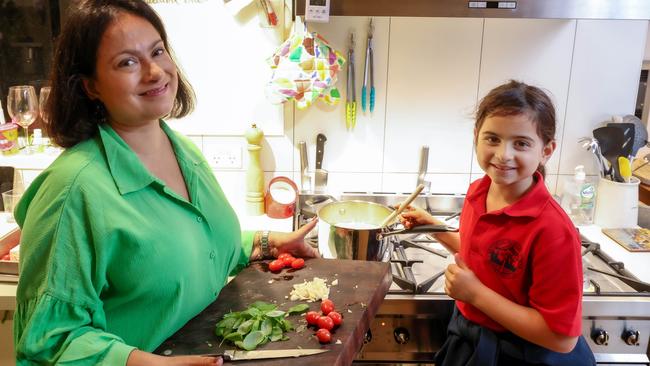Cost of living: We reveal how much more you’re paying at the checkout and will pay for services
You won’t believe how much more you’re paying at a leading supermarket for a piece of scotch fillet steak, compared to the same time two years ago. Can we still afford to eat it?

Victoria
Don't miss out on the headlines from Victoria. Followed categories will be added to My News.
Victorians reeling from rising grocery costs, as wages remain stagnant, can save thousands of dollars a year by shopping smarter.
The checkout shock comes as winter looms and people face lifts in energy bills, housing affordability diminishing and out of pocket medical cost blowouts.
Carnivores are feeling the pinch with a Coles scotch fillet steak priced at $43.75 per kilogram, up from$29.17 at the same time in 2020.
Coles has porterhouse steak at $40 per kilogram, nearly $11 more than the 2020 advertised price of $29 per kilogram.
A Sunday Herald Sun survey showed big price rises, mainly in healthy fruit and vegetables, while chocolate biscuits and blocks and chocolate were on special for $2 and $2.50.
Prices, from May, 2020, up against prices for this week revealed a mixed bag. While some items were stable, some pegged as part of supermarket promotions, others have snuck up.
We keep hearing about $5 iceberg lettuces but many of us are giving $14.99 a kilogram red capsicums a double take.
At Coles Jazz apples have gone up by 33 per cent from $4.50 per kg to $6.
Brushed potatoes worked out at $1.50 per kilo in a 3kg but now cost $2.25 a kilogram.
Navel oranges are up $1.40 a kilogram to $4.90. Weather conditions are factors in some of the increases.
At the same time, a number of items are unchanged. These included Bulla thickened cream $2.50; Western Star spreadable butter 375g $5; Arnotts Chocolate Ripple and scotch Finger $3.
Popular subscription toilet paper company Who Gives a Crap just upped its price for a box of 48 rolls from $52 to $58, citing rising costs it could no longer absorb.
Choice revealed this week that 83 per cent of people surveyed were anxious about the cost of food and groceries.
Choice editor Marg Rafferty encouraged people to shop smarter, look at unit prices, buy what they can use and store and reduce waste.
“Food waste typically costs households a whopping $2,000 to $2,500 per year, so it helps to reduce it where you can,” she said.
The quarterly Pulse tracks financial pressures on Australian households, taking in groceries, petrol, insurance premiums and energy bills.
“Cost of living pressure has become a major issue and it is not hard to see why when almost 90 per cent of Australians are seeing the price of daily essentials rise faster than their capacity to pay for them,” Ms Rafferty said.
Richmond mother of two Pooja Magennis said her family was conscious of trying to shop smarter and waste less as a way of life.
“We try to take a commonsense and sustainable approach to shopping and cooking to minimise waste,” she said.
With daughters Anisha, 6, and Sophia, 8, Ms Magennis said they often cooked from scratch and used lemons, chives, basil, thyme and mint from the garden.
“I do supplement a bigger shop with a smaller shop to get some fresh items as we need them,” she said.
Ms Magennis said they regularly attended the Gleadell St Market, in Richmond, each Saturday to buy competitively priced fruit and veg.
“Like many families we are busy so I do tend to meal plan which means we use the ingredients on hand and waste less,” she said.
St Vincent de Paul energy specialist Gavin Dufty said price rises were on the way for winter heating bills.
He said the underlying wholesale price of electricity had doubled so non-solar homes would be particularly hit and could expect anything from 20 to 30 per cent increases.
“It really depends on the retailer but if it is passed on it will be up to 30 per cent,” he said.
Mr Dufty urged people eligible for any energy concessions to sign up for them.
People holding pensioner, health care and veterans cards are eligible for 17.5 per cent off their electricity bill and over winter, from May to October 17.5 of their gas bill
Essential Services Commission data from early this year showed there was $260m in electricity bills under hardship payment plans, deferred or in arrears. For gas the figure was $163m.
Mr Dufty said anyone facing hardship should contact their supplier to come up with a plan.
Beyond that he suggested people look at their energy deals and shop around.
In its April update the ESC said consumers were being sucked into ‘buy now, pay later’ loans to pay utility bills and then faced debt collection.
The just released Per Capita report into housing affordability said many people were facing rental spikes and low vacancy rates.
Since the start of the pandemic median house prices in Australia have risen 31 per cent, breaking through the million dollar mark in Sydney and Melbourne for the first time.
“Rent prices across Australia have risen by almost 10 per cent over the 12 months to March 2022,” the Housing Affordability in Australia report said.
It found housing stress, including both mortgage and rental stress, is up. “By some measures, mortgage stress has doubled in five years from 20 to 40 per cent,” it said.
It found that 54 per cent of low income renters are in rental stress. It forecast a new cohort of stressed renters in rural and regional areas who left the city due to the pandemic.


